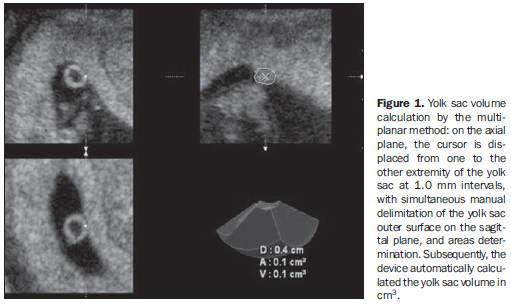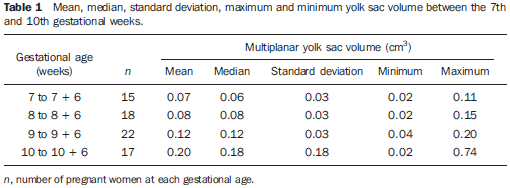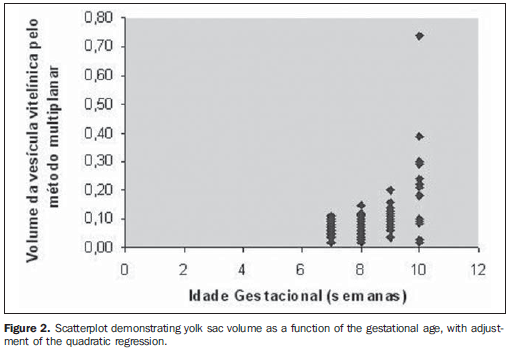Radiologia Brasileira - Publicação Científica Oficial do Colégio Brasileiro de Radiologia
AMB - Associação Médica Brasileira CNA - Comissão Nacional de Acreditação
 Vol. 42 nº 6 - Nov. / Dec. of 2009
Vol. 42 nº 6 - Nov. / Dec. of 2009
|
ORIGINAL ARTICLE
|
|
Correlation of yolk sac volume obtained by three-dimensional ultrasonography with the gestational age at 7-10 weeks utilizing the multiplanar method |
|
|
Autho(rs): Liliam Cristine Rolo, Luciano Marcondes Machado Nardozza, Edward Araujo Júnior, João Bortoletti Filho, Paulo Martin Nowak, Antonio Fernandes Moron |
|
|
Keywords: Yolk sac, First trimester of pregnancy, Gestational age, Prenatal ultrasonography, Three-dimensional imaging |
|
|
Abstract:
IMasters, MDs, Division of Fetal Medicine, Department of Obstetrics - Universidade Federal de São Paulo/Escola Paulista de Medicina (Unifesp/EPM), São Paulo, SP, Brazil
INTRODUCTION Ultrasonography utilized in the routine prenatal follow-up has allowed the monitoring of the first gestational trimester and the recognition of early signs suggestive of miscarriage(1). The yolk sac (YS) is an extra-amniotic structure detectable at two-dimensional ultrasonography (2DUS) even before the embryo can be identified, at about the 5th gestational week. The YS is the origin of blood vessels and promotes nutrients transfer to the embryo(2). As the embryo grows, the YS endoderm passively forms the embryonic bowel and, progressively, the previously existing communication between the YS and the embryos is closed. From the 12th week, the presence of the YS is not detected anymore, since it has already been completely incorporated into the umbilical cord. During the first gestational trimester, some parameters, such as small diameter of the gestational sac(3) and absence, or even YS deformity(4), were observed at 2DUS and associated with a poor gestational prognosis. Additionally 2DUS images have demonstrated that the YS diameter exponentially increases in the period between the 5th and the 11th weeks(5), and then presents a significant decrease, as the embryo develops. Other studies have evaluated the YS characteristics and sizes in the setting of gestational loss, particularly in cases of abnormal YS diameter(5-7). The first study developed with three-dimensional ultrasonography (3DUS) for evaluating the YS volume by means of the multiplanar method has observed an exponential increase in volume between the 5th and 8th gestational weeks, with later decrease between the 8th and 10th weeks(8). A study in the literature, has utilized the virtual organ computer-aided analysis (VOCAL) in the determination of the YS volume(9). The increasing relevance of 3DUS as a complementary obstetric imaging method, particularly at the first gestational trimester, has guided the present study whose objective is to evaluate the correlation of the YS volume measured by the multi-planar method with the gestational age between the 7th and 10th weeks.
MATERIALS AND METHODS In the period from November 2006 to March 2008, a cross-sectional study was developed with 72 healthy pregnant women between the 7th and 10th gestational weeks. Such study was approved by the Committee for Ethics in Research of Universidade Federal de São Paulo/Escola Paulista de Medicina (Unifesp/EPM), under No. 1492/06. The selected patients accepted to voluntarily participate in the study and signed a term of free and informed consent. The patients came from the SUS - Sistema Único de Saúde (the Brazilian health system) in the city of São Paulo, and from the Division of Low-Risk Prenatal Follow-up of Unifesp/EPM. Inclusion criteria were the following: singleton gestation with live embryo, and gestational age calculation based on the first day of the last menstrual period, confirmed by ultrasonography performed up to the 10th week utilizing the crown-rump length as a parameter. Exclusion criteria were the following: vaginal bleeding up to the 20th week, pregnancy resulting from infertility treatment, women with chronic clinical disease (chronic arterial hypertension, diabetes mellitus, colagenosis, among others), uterine malformations, tobacco or illicit drugs users, and use of either abortive or teratogenic drugs. All the studies were performed at the Unit of Three-Dimensional Ultrasonography, Department of Obstetrics - Unifesp/EPM, São Paulo, SP, Brazil, and all the patients were evaluated only once (crosssectional study) in a SA-8000LIVE equipment (Medison; Seoul, Korea) with a multifrequency volumetric endocavitary transducer. Two sonographers with experience in obstetric 3DUS performed the examinations, but only one of them performed the off-line 3D reconstructions and the YS volume calculations with the aid of the software Sonoview Pro version 1.03 (Medison; Seoul, Korea). Initially, a 2D, real-time US scan was performed to measure the crown-rump length, the mean gestational sac diameter (arithmetic mean of the three largest diameters) and evaluating the embryonic heart frequency. Subsequently, the 3D function was selected and the scan window (BOX) was positioned perpendicularly to the plane of the gestational sac at a 30º scanning angle (region of interest). After automatic scanning (regular mode) the all the three orthogonal planes were simultaneously displayed on the screen: transverse or axial plane (A) (at the upper left corner of the screen); longitudinal or sagittal plane (B) (at the upper right corner of the screen); and frontal or coronal plane (C) (lower left corner of the screen). The YS volume was calculated by the multiplanar method after the 3D images capture, utilizing the B (sagittal) plane as a reference. On the axial (A) plane, the cursor was displaced at 1.0 mm intervals from one extremity to the other of the YS, with simultaneous manual delimitation of the outer YS surface in the sagittal plane (B) and determination of the respective areas. Subsequently, and based on these areas, the device automatically calculated the volume in cm3 (Figure 1).
The data were stored on an Excel worksheet (Microsoft Corp.; Redmond, EUA) and statistically analyzed through the Windows SPSS version 13.0 (SPSS Inc.; Chicago, USA). For the YS volume, mean, median, standard deviations, and minimum and maximum values for each gestational age were calculated. Polynomial regression was utilized for evaluating the correlation between YS volume and gestational age, with adjustments by the determination coefficient R2. The significance level of 0.05 (p = 0.05) was utilized for such analyses.
RESULTS The population sampling included 72 pregnant women between seven and tem complete gestational weeks. The selected patients were compliant with the exclusion/inclusion criteria and underwent first and second trimester morphological fetal study and, therefore, included in the final statistical analysis. The patients' ages ranged from 20 to 41 years (mean, 30 years; standard deviation, 7.2 years) and parity status ranging between one and nine (mean, 2; standard deviation, 1.7). The multiplanar method was adopted for measuring the YS volume, with the mean volume ranging from 0.07 (0.02- 0.11) to 0.20 cm3 (0.02-0.74), between the 7th and 10th weeks (mean, 0.11 cm3 ± 0.10 cm3). Table 1 shows mean, median, standard deviation, minimum and maximum values for the YS volume at each gestational age evaluated. It was demonstrated that the YS volume is poorly correlated with the gestational age (GA), that is best represented by the quadratic regression corresponding to the following equation: YS volume = 0.9757 - 0.2499 × GA + 0.0172 × GA2, with R2 = 0.234. Figure 2 shows a scatterplot demonstrating YS volume as a function of the gestational age, as well as the poor correlation between both factors.
DISCUSSION Two-dimensional US at the first gestational trimester provides relevant information on the embryo feasibility and accurately defines the gestational age(10). Some parameters such as small mean gestational sac(3) and YS absence or deformity(4) during this gestational period were correlated with abnormal gestational results(2). Several studies utilizing 2DUS have correlated alterations in the YS diameter and shape with adverse gestational results(4,6,7). Küçük et al.(6) have evaluated 250 singleton pregnancies at the first trimester, with 31 presenting abnormal results. Among these 31 pregnant women, 20 had YS diameter > two standard deviations. The advent of 3DUS has allowed a more accurate volumetric evaluation of irregularly shaped objects because of the better delimitation of their outer surface(11-13). Studies approaching new normality parameters for the first gestational trimester at 3DUS, such as embryo volume(14,15) and YS volume(8-10), already can be found in the literature, and some of these studies have also correlated 3DUS parameters at the first trimester with adverse gestational results. Cho et al.(4) have reported that, in the presence of a heart beating embryo, with irregular or hydropic YS, or even an early disappearance of the YS, the gestation could result in miscarriage. Kupesic et al.(8) have evaluated pregnant women between 6th and 10th gestational weeks and measured the YS volume by means of 3DUS with the multiplanar method, observing a correlation between YS volume and gestational age, with an exponential increase in volume up to the 10th week and later decrease. Figueras et al.(9) have analyzed pregnant women between the 6th and 10th gestational weeks, also utilizing the VOCAL method. Their results have demonstrated a correlation between spontaneous miscarriage and YS diameters below the 5th percentile and above the 95th percentile for the respective gestational ages. The multiplanar method with volumetric technique was chosen because its availability from the first generation of 3DUS systems (Combison 330) and proved in vitro accuracy(12). Additionally, this technique has already been utilized for measuring the volume of first trimester structures such as gestational sac(10) and placenta(16), besides the YS itself(8). In the present study, the mean YS volume measured by the multiplanar method ranged from 0.07 (0.02-0.11) to 0.20 cm3 (0.02-0.74), between the 7th and 10th gestational weeks (mean, 0.11 cm3). It is important to note that the values found in the present study are overestimated in relation to the ones found by Kupesic et al.(8) and Cosmi et al.(17), who have utilized the same volumetric technique adopted in the present study. In the first study, the authors have observed that the mean YS volume ranged from 0.037 cm3 to 0.058 cm3, while in the second study, the mean YS volume in healthy pregnant women ranged from 0.020 cm3 to 0.082 cm3. In a previous study developed by our group with this same population group, but utilizing the VOCAL method (with 30º rotation angle) as a volumetric technique, they observed that the mean volume ranged from 0.06 to 0.16 cm3, proving that both techniques are in agreement(18). In a study developed for evaluating the first trimester placental volume, it has been demonstrated that the multiplanar method (1.0 mm intervals), VOCAL 30º (six consecutive planes) and VOCAL 12º (15 consecutive planes) methods are in agreement(17). The main advantage of the VOCAL 30º method is the quickness and practicality, but, considering that the YS is a small and relatively regular structure, it is believed that both techniques are feasible for measuring the YS volume. The authors observed a poor correlation between gestational age and YS volume that is best represented by quadratic regression (R2 = 0.234). In a previous study utilizing the VOCAL method, the authors have also observed a poor correlation between YS volume and gestational age, best represented by the quadratic equation (R2 = 0.188). Such correlation level was already expected because, as the YS reaches its maximum volume, approximately at the 10th gestational week, the degeneration process resulting from the decrease in vascularization has already been initiated(8).
CONCLUSION The YS volume measured by means of 3DUS presented a poor correlation with the gestational age between the 7th and 10th weeks of gestation.
REFERENCES 1. Jurkovic D, Gruboeck K, Campbell S. Ultrasound features of normal early pregnancy development. Curr Opin Obstet Gynecol. 1995;7:493-504. [ ] 2. Moore KL. The placenta. In: Moore KL, Persaud TVN, editors. The developing human: clinically oriented embryology. 7th ed. Philadelphia: WB Saunders; 1993. p. 110-8. [ ] 3. Trahair JF, Harding R. Ultrastructural anomalies in the fetal small intestine indicate that fetal swallowing is important for normal development: an experimental study. Virchows Arch A Pathol Anat Histophatol. 1992;420:305-12. [ ] 4. Cho FN, Chen SN, Tai MH, et al. The quality and size of yolk sac in early pregnancy loss. Aust N Z J Obstet Gynaecol. 2006;46:413-8. [ ] 5. Jauniaux E, Jurkovic D, Henriet Y, et al. Development of the secondary human yolk sac: correlation of sonographic and anatomical features. Hum Reprod. 1991;6:1160-6. [ ] 6. Küçük T, Duru NK, Yenen MC, et al. Yolk sac size and shape as predictors of poor pregnancy outcome. J Perinat Med. 1999;27:316-20. [ ] 7. Cepni I, Bese T, Ocal P, et al. Significance of yolk sac measurements with vaginal sonography in the first trimester in the prediction of pregnancy outcome. Acta Obstet Gynecol Scand. 1997;76:969-72. [ ] 8. Kupesic S, Kurjak A, Ivancić-Kosuta M. Volume and vascularity of the yolk sac studied by three-dimensional ultrasound and color Doppler. J Perinat Med. 1999;27:91-6. [ ] 9. Figueras F, Torrents M, Muñoz A, et al. Three-dimensional yolk and gestational sac volume. A prospective study of prognostic value. J Reprod Med. 2003;48:252-6. [ ] 10. Babinszki A, Nyari T, Jordan S, et al. Three-dimensional measurement of gestational and yolk sac volumes as predictors of pregnancy outcome in the first trimester. Am J Perinatol. 2001;18:203-11. [ ] 11. Raine-Fenning NJ, Clewes JS, Kendall NR, et al. The interobserver reliability and validity of volume calculation from three-dimensional ultrasound datasets in the in vitro setting. Ultrasound Obstet Gynecol. 2003;21:283-91. [ ] 12. Riccabona M, Nelson TR, Pretorius DH. Three-dimensional ultrasound: accuracy of distance and volume measurements. Ultrasound Obstet Gynecol. 1996;7:429-34. [ ] 13. Hösli IM, Tercanli S, Herman A, et al. In vitro volume measurement by three-dimensional ultrasound: comparison of two different systems. Ultrasound Obstet Gynecol. 1998;11:17-22. [ ] 14. Blaas HG, Eik-Nes SH, Berg S, et al. In-vivo three-dimensional ultrasound reconstructions of embryos and early fetuses. Lancet. 1998;352:1182-6. [ ] 15. Blaas HG, Taipale P, Torp H, et al. Three-dimensional ultrasound volume calculations of human embryos and young fetuses: a study on the volumetry of compound structures and its reproducibility. Ultrasound Obstet Gynecol. 2006;27:640-6. [ ] 16. Nowak PM, Nardozza LMM, Araujo Júnior E, et al. Comparison of placental volume in early pregnancy using multiplanar and VOCAL methods. Placenta. 2008;29:241-5. [ ] 17. Cosmi E, Piazze JJ, Ruozi A, et al. Structural-tridimensional study of yolk sac in pregnancies complicated by diabetes. J Perinat Med. 2005;33:132-6. [ ] 18. Rôlo LC, Nardozza LMM, Araujo Júnior E, et al. Yolk sac volume assessed by three-dimensional ultrasonography using the VOCAL method. Acta Obstet Gynecol Scand. 2008;87:499-502. [ ] Received May 9, 2009. * Study developed at Unit of Three-Dimensional Ultrasonography, Department of Obstetrics - Universidade Federal de São Paulo/Escola Paulista de Medicina (Unifesp/EPM), São Paulo, SP, Brazil. |
|
Av. Paulista, 37 - 7° andar - Conj. 71 - CEP 01311-902 - São Paulo - SP - Brazil - Phone: (11) 3372-4544 - Fax: (11) 3372-4554



